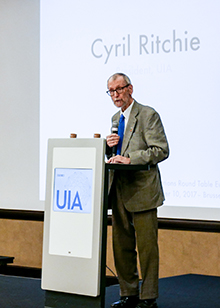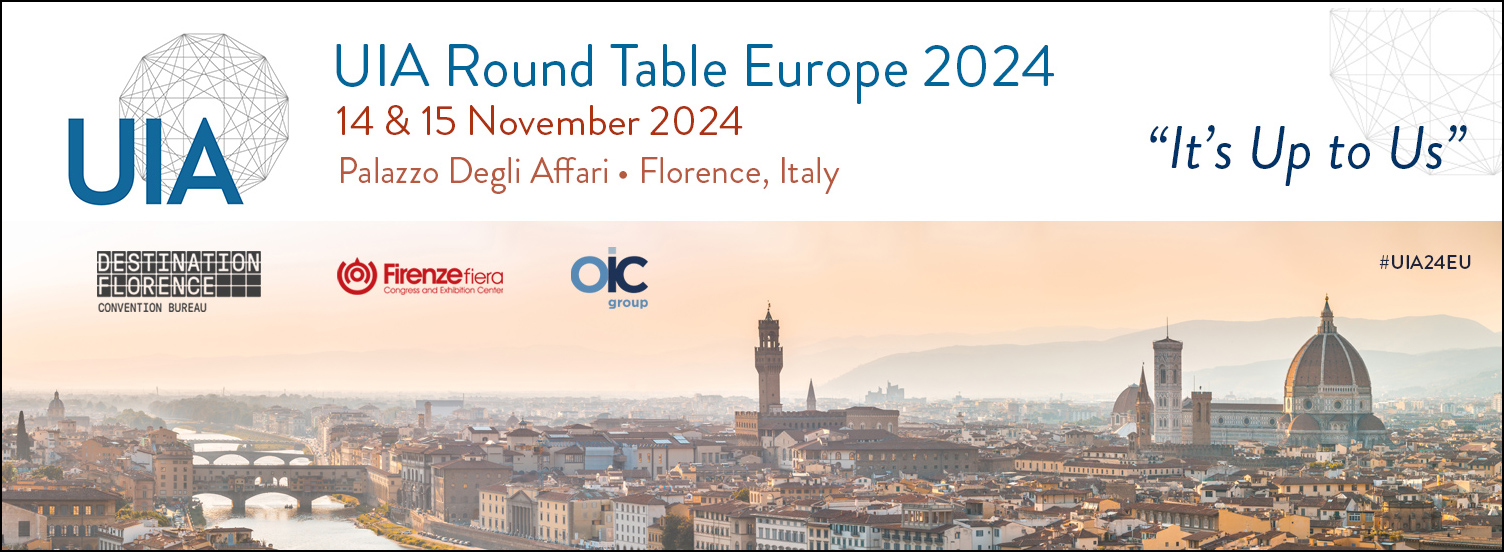

As I welcome participants and express appreciation to our hosts of this Round Table, I should like to underline that it is the Florence hosts who coined the slogan for this Round Table, namely ‘It’s up to us’. My own message for many years to associations and to civil society in general has been precisely that: IT’S UP TO US to make the world a better place for humanity; to achieve greater social and climate justice; to work for sustainable development, for gender equity and for communal prosperity; and above all in today’s world turbulence, to outlaw war and bring peace to the planet. Rather appropriately, the words ‘It’s up to us’ are a most fitting sub-theme for what I am now going to say in my Keynote Statement, focussed on the United Nations Summit Of The Future – its origins and its outcomes. In the light of all the urgent world needs and causes that I have just mentioned, and which were to varying degrees addressed in this Summit, I am convinced that the Summit Of The Future was and is highly relevant to associations.
I shall start by recalling the role of the United Nations System in working for all those admirable, and yet still elusive, goals that I mentioned in my first sentences (justice, equity, peace, sustainability and more). The United Nations Charter, adopted in 1945 as the world exited from a calamitous world war, set high standards for the conduct of governments vis-à-vis each other, and vis-à-vis their own peoples. These standards of course included the banishment of aggression, achieving human rights for all, and the organization of a multilateral world order based on the rule of law. The United Nations System – with its 50-plus entities, agencies, commissions, institutes and other designations – has worked persistently and imaginatively for 79 years to achieve the goals set out in the Charter. That we are farther than ever from that utopia is not the fault of the United Nations as an Organization but of those governments which are its Members and which do not abide by the Charter that they have all signed and committed to observe. Certain governments launch wars, imprison defenders of human rights and the environment, and/or shrink civil society space and fundamental freedoms – and by the way, it is governments which do not adequately fund the United Nations to carry out the manifold tasks assigned to it.
The UN Summit Of The Future was conceived by the UN Secretary General, Antonio Guterres, as a ‘once-in-a-generation opportunity to reinvigorate global action, to recommit to fundamental principles, and further develop the frameworks of multilateralism’. In short, the Summit Of The Future (henceforth SOTF) was to be an effort to restore the values of the UN Charter to centre stage, to bring multilateral cooperation to its necessary central place in a well-functioning world order, and to update the international mechanisms and procedures put in place in 1945 and later. The SG’s initial proposals, contained in his 2021 document ‘Our Common Agenda’ (UN Document A/75/982) included (i) action to strengthen global governance, notably in the areas of global health, finance and economics; (ii) future-oriented policy-making to incorporate the interests of succeeding generations; (iii) renewing social contracts, such as assuring universal rights and educational opportunities, along with decent work and extended social protection; and (iv) re-examining UN System structures to make ‘a UN fit for a new era’, including creating greater space for civil society. Guterres stated bluntly that humanity was facing either a breakdown or a breakthrough, and that ‘The choice is ours to make’. You will note there the echo of the Florence slogan ‘It’s up to us’!
Was all this simply wishful thinking? In the years following the report ‘Our Common Agenda’, government representatives met for innumerable days and weeks to thrash out what a Summit Of The Future should and could do. Drafts of an outcome document, that became known as The Pact for the Future, went through multiple versions right up until the last days before the Summit opened, and as with all such intergovernmental negotiations involved uncountable compromises on intent and wording – blasé observers often refer to this process as horse-trading… In parallel to these intense intergovernmental deliberations, associations and civil society organizations in the largest sense set up variegated consultation structures and mechanisms to bring a myriad of non-governmental perspectives to the table. The UN also consulted think tanks, research institutions, and business constituencies. Of course all UN System agencies and entities were engaged in the SOTF preparations, for as with civil society they too deal with real issues on the ground – in hospitals, in schools, in market places, in law courts. UN agencies and civil society associations deal with the consequences for civilian populations of the wars, famines, displacements, catastrophes, medical and other emergencies that governments have been unable to avoid or overcome, and indeed too often have provoked.
Keeping all this background in mind, what did the SOTF accomplish? It is first of all to be noted that the main outcome, the Pact for the Future, is accompanied by two annexes: A Global Digital Compact, and a Declaration on Future Generations, which all together add up to a 61-page document. Overall, the outcome is certainly not as ambitious as associations and civil society hoped for and wanted. But it does contain pointers for the future – sometimes recommendations, sometimes commitments, sometimes aspirations – that entirely justify the immense amount of time and effort that went in to its construction, and that frequently meet the desiderata and expectations of associations and civil society. I shall give just a few examples, quoting the titles of some of the 56 Actions agreed upon in the Pact for the Future, as decisions made by the more than 180 Heads of State and Government who adopted the Pact.
Action 1: We will take bold, ambitious, accelerated, just and transformative actions to implement the 2030 Agenda, achieve the Sustainable Development Goals and leave no one behind.
Action 4: We will close the Sustainable Development Goal financing gap in developing countries.
Action 8: We will achieve gender equality and the empowerment of all women and girls as a crucial contribution to progress across all the Sustainable Development Goals and targets.
Action 14: We will protect all civilians in armed conflict.
Action 24: We will prevent and combat transnational organized crime and related illicit financial flows.
Action 25: We will advance the goal of a world free of nuclear weapons.
Action 28: We will seize the opportunities presented by science, technology and innovation for the benefit of people and planet.
Action 30: We will ensure that science, technology and innovation contribute to the full enjoyment of human rights by all.
Action 35: We will promote, protect and respect the human rights of all young people and foster social inclusion and integration.
Action 47: We will accelerate reform of the international financial architecture to address the challenges of today and tomorrow.
Action 54: We will strengthen the international response to complex global shocks.
Furthermore, the Global Digital Compact includes among its Objectives ‘To expand inclusion in and benefits from the digital economy for all’ and ‘To foster an inclusive, open, safe and secure digital space that respects, protects and promotes human rights.’
The more sanguine among you may now be thinking ‘Oh well, haven’t we heard much of this before ?’ And even ‘So who‘s going to make sure that all that gets done?’ To which I have two comments. Firstly, yes, indeed many of the commitments of the Pact are reiterations or reshaping of previous high-level decisions. What should be noted is that each of the 56 Actions is completed by several paragraphs that spell out the steps needed. (If I were to enter into the detail, we would be here until midnight!) Secondly, the Heads of State and Government set several timelines and procedures for follow up, reporting and review. And here again is where civil society associations have a vitally important role to play. Very many of the Pact’s Actions, Objectives and decisions touch directly the goals, programmes, activities and purposes of associations in their daily and yearly work around the world. The diversity of actions undertaken by associations puts us in the front line of monitoring follow up to the Summit and of advocating at international and national level for IMPLEMENTATION.
Indeed, IMPLEMENTATION is the one-word answer to the question posed in the title of this Keynote Statement: ‘What happens next?’. Secretary General Guterres could scarcely have been clearer on this issue when he addressed the farewell protocol gathering of the Heads of State and Government before they left New York. He did not treat it as a congratulatory occasion; he simply said ‘Ladies and gentlemen: NOW IT’S IMPLEMENTATION TIME!’ Indeed, he has already given one practical illustration of what that means. The Declaration on Future Generations contains a rather weak paragraph 32 in which governments simply ‘take note of the SG’s proposal to appoint a Special Envoy for Future Generations to support the implementation of this Declaration’. Within two weeks of the Summit, Secretary General Guterres announced the impending appointment of this Special Envoy. This has been enthusiastically welcomed by the many NGOs that have for almost two decades been advocating for such an appointment. The UN’s wheels often turn slowly, but persistent and competent advocacy by civil society has often led to breaking through bureaucratic or political disinterest.
So my call to all civil society associations and organizations, whatever your field or constituency of action and policy, is to determine which of the themes and proposals of the Summit Of The Future are relevant to your values and goals. Which Summit proposals resonate with your members? Which Summit aspirations find echoes in your programmes? And what steps can you take to implement, in whole or in part, the worthy objectives of the Pact for the Future? I will close with one last quotation from the UN Secretary General, extracted from his statement on the Summit to the (79th) UN General Assembly currently in session: ‘The people of the world are looking at us – and succeeding generations will look back on us. Let them find us on the side of the United Nations Charter… on the side of our shared values and principles… and on the right side of history’.
It won’t be easy to achieve all that the Summit documents promise, but it is imperative that we make the effort. IT’S UP TO US!

Issue #15 – February 2025